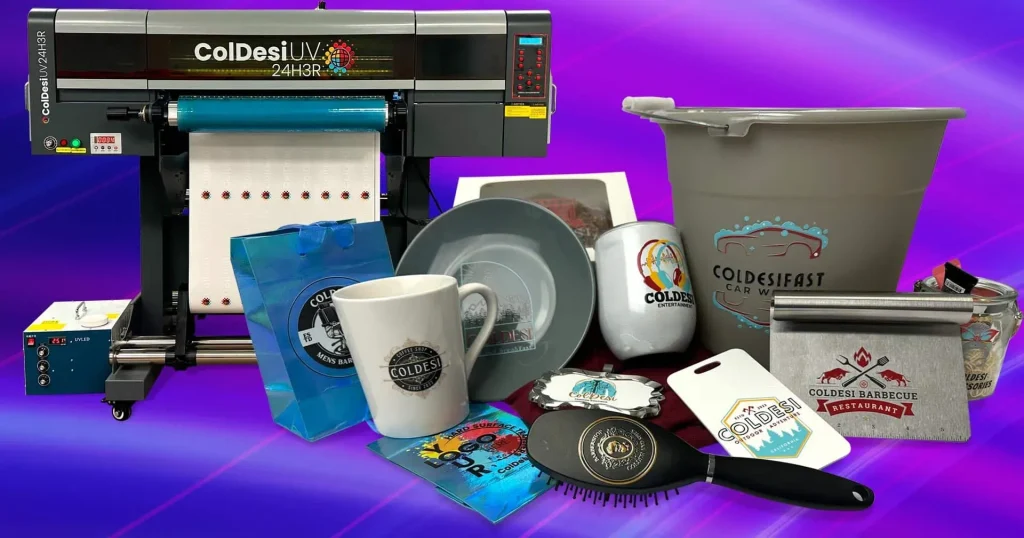UV DTF printing, or Ultraviolet Direct to Film printing, is transforming the printing landscape by integrating the power of UV technology with the efficiency of direct to film processes. This cutting-edge method allows for vibrant color reproduction across a multitude of substrates, including textiles, plastics, and more. In this article, we will delve into essential UV printing tips that can help you optimize your results and enhance durability. By understanding various UV DTF printing techniques, you’ll be better equipped to tackle printing on different materials, ensuring high-quality output every time. Get ready to explore the best practices of UV DTF printing and elevate your printing game!
Known alternatively as Ultraviolet Direct to Film printing, this innovative technique harnesses the combination of UV curing and direct transfer technology to produce stunning prints. By provoking a chemical reaction that instantly hardens the ink, manufacturers can now print on various materials with remarkable ease and speed. This process supports a wide array of substrates suitable for UV printing, giving designers and print providers more flexibility than ever before. Understanding the intricate details of DTF technology and its application in printing allows you to leverage its full potential, leading to vibrant and lasting results.
Exploring the Benefits of UV DTF Printing
UV DTF (Direct to Film) printing offers a fantastic combination of speed, efficiency, and flexibility. This printing method stands out because it employs ultraviolet light to instantly cure inks, allowing for immediate handling and shipping of printed products. The ability to print on various substrates, such as textiles and plastics, makes UV DTF an attractive option for businesses looking to diversify their offerings. As the technology advances, more artists and businesses are discovering the exceptional color vibrancy and detail that UV DTF printing can achieve.
Moreover, the durability of prints produced through UV DTF cannot be overlooked. Due to the curing process, these prints exhibit excellent resistance to fading, scratching, and washing. Users can enjoy confidence in the longevity of their prints, which is crucial for products requiring frequent use, such as apparel and promotional materials. This durability, coupled with cost-effective production, solidifies UV DTF printing as a top choice for businesses aiming to produce high-quality prints.
Essential Tips for Choosing Substrates in UV DTF Printing
Selecting the right substrates is fundamental to achieving the best results in UV DTF printing. Not all materials will adhere properly to the inks used in this process. For instance, substrates such as treated fabrics, coated metals, and specially prepared plastics often yield the best results, displaying vivid colors and excellent adhesion. It is imperative to ensure that these materials are compatible with UV inks to avoid issues like peeling or fading.
Additionally, experimenting with different substrates can lead to exciting new applications. Some printers have successfully utilized unconventional materials like wood or glass, broadening the scope of creative opportunities. However, careful testing is essential to determine the curing times and settings that will optimize the printing process for diverse substrates, ensuring vibrant and lasting results.
The Importance of Printer Settings for Optimal UV DTF Results
Optimizing printer settings is crucial when working with UV DTF technology. Each substrate type requires unique adjustments to achieve the perfect balance between ink load, curing intensity, and print speed. For example, increasing the ink load can enhance color vibrancy, but too much ink may lead to bleeding and loss of detail. Additionally, the curing intensity must be calibrated appropriately; insufficient UV exposure can result in prints that lack durability, while overexposure can degrade the printed layer.
Incorporating routine maintenance into your workflow is also key to ensuring optimal prints. Regularly checking printheads and conducting calibration will significantly improve the output quality over time. By refining these settings, printers can maximize the performance of their UV DTF machines and achieve consistently excellent results.
Mastering Curing Techniques in UV DTF Printing
The curing process in UV DTF printing is a defining element that can affect print quality. Mastering this technique is vital to producing vibrant and durable prints. Each substrate requires different curing times to achieve maximum adhesion without sacrificing quality. Testing various settings during the trial phase allows printers to identify the sweet spot that yields the best results.
Using reliable curing equipment is equally important. Advanced UV curing machines and LED lights help ensure even light distribution which is crucial for achieving uniform curing across the print area. Consistent curing results in enhanced durability, which is particularly beneficial for products that will encounter frequent exposure to wear and tear.
Post-Printing Care and Finishing Techniques
After completing a UV DTF print, applying proper post-printing care is essential for maintaining quality. Protective coatings can significantly enhance the longevity and resistance of the printed materials against scratches and other damages. In particular, coatings designed for UV prints play a significant role in safeguarding the vibrancy and integrity of the design.
Additionally, careful handling and storage practices should not be underestimated. Properly storing finished prints can prevent unnecessary damage and ensure that they maintain their quality before reaching customers. Developing a post-printing checklist can streamline this process and help ensure that every print delivered is in the best condition possible.
Emerging Technologies and Trends in UV DTF Printing
The landscape of UV DTF printing is continually evolving with advancements in technology and tools that enhance the printing process. Innovations in software, such as improved RIP software tailored specifically for UV printing, facilitate better color management and increase workflow efficiency. Keeping up with these advancements is vital for businesses looking to remain competitive in the market.
Additionally, recent cost-reduction trends in UV DTF equipment are making it more accessible to a wider range of users. These developments mean that even small businesses can invest in high-quality, advanced printing systems without breaking the bank. As a result, more companies are exploring the potential of UV DTF printing to expand their offerings and improve their production capabilities.
Frequently Asked Questions
What are the key advantages of UV DTF printing compared to traditional methods?
UV DTF printing merges the rapid curing of UV printing with the versatility of Direct to Film printing, allowing for vibrant, durable prints on various substrates. This method reduces production times, enhances color vibrancy, and offers the ability to print on a wide range of materials such as fabrics, plastics, and coated metals.
How do I choose the best substrates for UV DTF printing?
Selecting the right substrates for UV DTF printing is crucial for good adhesion and print longevity. Ideal substrates include treated fabrics, plastics, coated metals, and wood. Ensure that your chosen materials are compatible with UV inks to avoid adhesion problems and extend the life of your prints.
What are the recommended UV DTF printing techniques for optimal results?
To achieve optimal results in UV DTF printing, focus on selecting high-performance films, optimizing printer settings such as ink load and curing intensity, and ensuring proper curing techniques. Experimenting with different curing times based on the substrate can also lead to improved print quality and durability.
How does the curing process affect UV DTF printing quality?
The curing process is critical in UV DTF printing. Proper curing ensures that the inks adhere well to the substrate and achieve maximum durability. Using the right UV curing equipment and adjusting curing times according to substrate requirements can enhance print longevity and prevent issues like fading.
What printer settings should I optimize for UV DTF printing?
When optimizing your printer settings for UV DTF printing, pay attention to ink load, curing intensity, and print speed. Balancing these factors is essential for achieving vibrant colors without bleeding, ensuring thorough curing, and maintaining print clarity.
Are there any emerging trends in UV DTF printing technology?
Yes, emerging trends in UV DTF printing include advancements in color management software, decreasing technology costs, and innovative tools improving productivity. Staying updated with industry trends helps printers to enhance their workflows and maintain a competitive edge.
| Key Points | Details |
|---|---|
| Understanding UV DTF | UV DTF printing utilizes UV light for curing inks, allowing immediate drying and enhanced durability. |
| Choosing the Right Materials | High-performance films and suitable substrates ensure vibrant colors and long-lasting prints. |
| Printer Settings Optimization | Adjust ink load, curing intensity, and print speed to achieve optimal print quality. |
| Proper Curing Techniques | Experiment with curing times and use reliable curing equipment for consistent results. |
| Post-Printing Considerations | Apply protective coatings and handle prints with care to maintain quality. |
| Emerging Trends and Tools | Stay updated with advancements in software and cost reductions in UV DTF technology. |
Summary
UV DTF printing is revolutionizing the printing landscape by combining the benefits of UV technology with DTF printing. This innovation offers vibrant and durable prints on a multitude of substrates, making it crucial for businesses looking to maximize their print potential. By understanding the intricacies of UV DTF, choosing the right materials, optimizing printer settings, and employing effective curing techniques, printers can significantly enhance the quality and longevity of their outputs. As this technology continues to evolve with emerging trends and tools, staying informed and adaptable is key to maintaining a competitive edge in the printing market.



